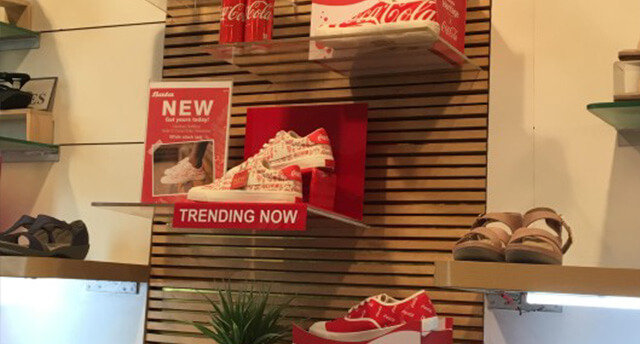Would you enthusiastically patronise #apple if it launched a series of apple coffee stores? Conversely, would you buy a #starbucks phone if it launched one?
- Would you be curious and willing to explore shared working spaces if they were promoted by #LinkedIn? Conversely, if #WeWork launched a powerful social media platform dedicated to entrepreneurs and start-up artists, would you be willing to create a profile on it?
- And do you buy more Coca Cola as a result of the alignment with #Bata (see picture taken by authors at a store in Mumbai) or buy more Bata footwear because of the #CocaCola partnership?
If you answered “Yes!” or even “Maybe!” to any of the above, you may agree with a proposition that brands are moving away from an indicator of product, features and quality to a set of values they represent. The underlying product or service while important in building the brand (as evidence of those values) is incidental. And you may also perhaps be willing to concede that brands with very similar attributes (but in different product categories) have a real opportunity to benefit from collaboration.
Brand collaborations are not new. #AmericanExpress has partnered for decades with premier #airlinesloyalty. As have #Nike and #Apple and #Starbucks and #Spotify.
In a previous post we deliberated how the choice of Pepsi or Coca Cola could be made depending on the choice of McDonalds vs. Burger King if not on the vector of price. Post the demonetisation of 85% of all currency notes by value in November 2016, mobile wallets seem to have become a new lever driving choice in India!
#Paytm has the largest market share and has the clout to announce Paytm First, a subscription-based loyalty program that manages subscription to other popular services such as Zomato, Gaana, Uber and Uber Eats in one place.
#PhonePe, with a substantially lower market share on the other hand, needs acquisition. And has aligned with Flipkart Super Coins that has over a 100 partner brands including #Zomato, #Oyo, and #MakeMyTrip.
Which begs the question, what will the outlook of brand partnerships look like in India?
We think brands would benefit to explore partnerships with complementary, non-conflicting partners in the same quadrant of the matrix proposed below (x-axis maps customers from price-sensitive on the left to quality-conscious on the right and y-axis maps customers from traditional / nationalistic at the bottom to liberal / global on the top):
So here’s the questions we’d love to have your thoughts and comments on:
- What quadrant (1, 2, 3 or 4) do you think the current coalitions / strategic partnerships in India sit in? (#FlipkartSuperCoins, #Jio, #PhonePe, #AmazonPrime, #TataEmpower, others)?
- What quadrant is an opportunity to create a powerful assembly of like-minded brands that complement one another in brand-values, frequency, emphasis on price vs. quality?
- Do you think mobile wallets can be a powerful acquisition lever in a brand basket? What would be your recommendations to #googlepay #RuPay #AmazonPay #ApplePay when looking for partners among the #olacabs #uber #BigBasket #BookMyShow among others?


Recent Comments